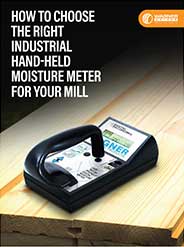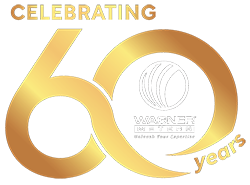Why the Rapid RH® Relative Humidity Is the Most Accurate Moisture Test
While uploaded in the early 2000s, this videos stands the test of time with its beneficial, science-based information. In the years since, we have updated our Rapid RH® product line — which is still the fastest, most accurate moisture test for concrete floors on the market.
The short video above talks with some concrete and flooring experts, who explain why the most reliable and accurate method of concrete moisture testing is relative humidity (RH) testing. One of the experts, Howard Kanare, reminds us that “There’s a clear and valid relationship between RH levels in concrete and floor system performance.” This relationship has been validated through scientific testing. Researchers have been able to specify the precise depth at which RH sensors should be inserted to get the most pertinent reading for determining whether the slab is ready for the flooring to be placed on top of it.
Our latest entry into our Rapid RH® line of concrete moisture tests: Rapid RH L6. The L6 builds off the accuracy and user-friendliness of earlier Smart Sensors from Wagner Meters. The Rapid RH L6 is both a more cost-efficient Smart Sensor and more responsive at the highest RH levels. It also has advanced data collection and storage capabilities that lets you document test readings with ease and confidence. Read on to learn more about the science behind the RH concrete moisture test to understand why professionals need a test they can rely on to provide an accurate RH reading.
How RH Is Used When Measuring Moisture in Concrete Flooring
Simply put, RH is the amount of moisture held in the air compared to the total amount of moisture the air could hold. That’s why RH is expressed as a percentage. The RH in concrete flooring is vital to understanding whether the moisture contained within is at a level where flooring can be safely installed on it.
That’s because once the floor covering is installed, the moisture that remains in the slab is effectively trapped, assuming there’s a vapor retarder below the slab. If concrete’s moisture level hasn’t equilibrated to the RH of the air around it before the flooring is installed, the excess moisture in the concrete will struggle to evaporate. That’s when bad things happen.
Studies have shown that the RH of air at a specific depth within the concrete (40% depth for slabs poured on grade) correlates with the final moisture content that the slab will equalize to after the floor covering is installed.
How the RH Level Affects Water Vapor Behavior in Concrete
If you’ve watched the video above (and you should), you heard that water vapor behaves differently in lower RH than it does at higher RH. This point is worth exploring.
The depth within the slab where the RH reading is taken is critical since the amount of water vapor isn’t consistent throughout the slab. Surface moisture tests are unhelpful in determining whether concrete is dry enough for flooring because they’re only measuring moisture on the surface. Concrete tends to hold more water at lower depths.
As Howard Kanare explained in the video, an RH level below 80% means the water molecules in the concrete are strongly absorbed in it. Thus, most floor coverings can tolerate below-80% RH well. Even so, complying with ASTM F2170 (standard test method for determining RH in concrete floor slabs using in situ probes) requires readings to be below 75% RH or the RH% required by the manufacturer. It’s imperative to wait to install any flooring until the RH readings match the manufacturer’s specifications. “Below 80% RH” is still a pretty big range, while many flooring covering products can be installed at higher RH levels.
Getting an Accurate RH Reading Is Critical for Successful Floor Installations
As noted above, manufacturers specify the acceptable RH level for each separate flooring product. These RH level guidelines aren’t suggestions. The manufacturer is telling you that the specified RH level indicates the maximum moisture conditions for the installation of that flooring product. Install the flooring if the RH level isn’t in the specified, accepted range, and you risk moisture-related flooring failure. Worse, many manufacturer warranties are void if the flooring was installed when the concrete’s RH level wasn’t at the acceptable RH percentage. The Rapid RH L6 digital data collection is greatly helpful here, as it provides a verifiable audit trail of moisture measurements and related data, like ambient temperature, and when they were taken.
Being able to track RH readings and other valuable data over time once the sensors are installed assists the project and time management since a person can see how the drying is progressing. As the data is tracked the progress of RH% readings can be provided to the GC and other stakeholders so all people involved can start to make decisions about how to proceed.

Free Download – Which Rapid RH Sensor is Right For You?
Don’t Risk the High Costs of Moisture-Related Flooring Failure
Remediation costs for concrete slabs and flooring coverings due to moisture-related flooring failures in North American commercial properties are estimated to reach $2.4 billion every year. This number doesn’t include costs to professional reputations and relationships when flooring failures occur. Flooring professionals and general contractors need reliable and accurate concrete moisture testing to protect their reputations and against potential moisture-related failures.
The scientific validation of the RH test method means only an RH test can provide reliably accurate information required to know when the slab is ready for the flooring to be installed to the manufacturer’s specifications. The Rapid RH L6 concrete moisture test makes data collection and retention easy, which means you get reliable information that helps you make smart decisions in a timely manner.
[sp_easyaccordion id=”46191″]




We are a roofing contractor and deal with concrete roof decks more and more frequently. The roofing manufacturers haven’t taken a stand on what an acceptable level of cure is in the slab officially. Could this system be used to help us determine if the slab has reached a sufficient level of cure to install the roofing reducing our risk of failure?
Matt:
Thanks for the question. First off, curing, or the hardening of the concrete happens as a function of time, without any real influence from exterior conditions. Typically you will see 50% compressive strength of the slab at 7 days and, roughly, 80-90% at 28 days. The manufacturers haven’t taken a stand on the acceptable moisture levels within the slab that they feel comfortable having their systems installed upon. Two very different things. Our system, although intended for interior applications, has been used in roofing applications to help show that levels were too high for installation. This is usually intended as a relative number due to large temperature fluctuations of the slab, but it can still be useful information. I hope this helps.
What is the temperature range? I can’t find a spec sheet on it.
Gordon:
Thanks for the question. The temperature range for the sensor used in the Rapid RH system is -40-257F. Here is the TDS for the raw sensor. https://www.sensirion.com/fileadmin/user_upload/customers/sensirion/Dokumente/0_Datasheets/Humidity/Sensirion_Humidity_Sensors_SHT25_Datasheet.pdf
Can Rapid RH meters be used to measure RH in masonry walls?
Mark:
Thanks for the question. At the end of the day, the device will test RH in a multitude of things. The question is, does the information tell you anything for the specific substrate. With concrete, we have science and product testing with maximum RH% thresholds. Many other applications won’t. Good luck.
Whay does H1 means in our Rapid RH moisture reader…
Thank you
If the RH% is 99.1% or higher, the reader will read “HI”. The LCD screen on the reader does not have room for 3 digits (i.e. 100) so it reads “HI”. If you have any further questions, feel free to give me a call: (541) 291-5123 ext. 235.
I was asked once; when using mechanical drying for a concrete slab after a water damage event and there is no time to let the dehumidification unit (turnoff) so when reading surface temperature and want to know a guesstimate temperature you to take 15%rh off +- . Have you heard of this and if so can you elaborate. thanks you
Ivi:
Thanks for the question. Unfortunately, I haven’t heard of such a guesstimate or methodology for what you are asking. The closest tool I am aware of to look at anything close to this might be the chart at the bottom of this page https://www.wagnermeters.com/concrete-moisture-test/relative-humidity-chart-for-concrete-temperature-adjustment/ which looks at impact on in situ RH% at service conditions vs other temps. Again good from a theoretical perspective. I hope all is well Down Under.
Jason
What kind of reduction in RH can be expected in a recently poured concrete slab? We have a project with slabs that were poured 1-2 months ago and the RH readings are too high to install flooring. Is there a “normal” rate of reduction that can be anticipated per week or month (e.g., loss of 2% per month)?
The rate of reduction is really based on the ambient conditions to which a slab is exposed. A “typical” rule of thumb is, it will take approximately 30 days of drying time for every 1 inch of slab thickness, for a slab to reach somewhere in the 85-90% RH range. Keep in mind, the clock starts once the building is enclosed and the ambient conditions are conducive for drying. There are many variables that can affect this, but this at least gives you an idea.